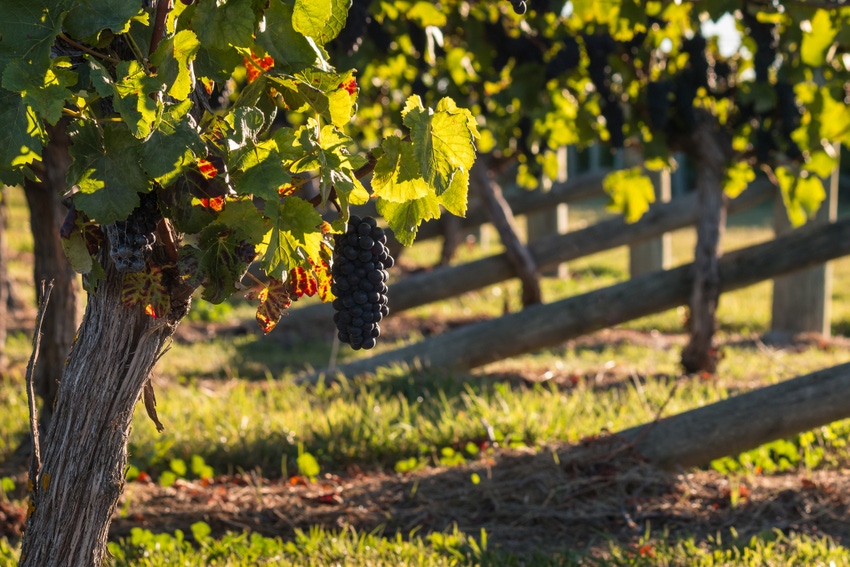
Clarksburg appellation wine grape grower Tim Waits was all smiles as he wrapped up the sixth harvest of his 75 acres of Pinot Noir on Sept. 8. Production averaged close to 9 tons per acre – exceeding his long-term average of 6.5 tons by more than 25 percent.
He was delighted with the quality of the fruit, too, which he picked at 24.5º to 25º Brix. “The flavors are really good, and the berry structure is fine with no rot,” he says. “We had almost ideal weather for growing grapes throughout the entire season, including a fairly wet winter for a change. The plants really appreciated the winter moisture and rewarded us with the bigger crop.”
The boost in yields also reflects his sustained effort to improve nutritional levels of the vines. That began three years ago when he enhanced his fertilizer program to correct soil and plant nutrient deficiencies that were causing spotty performance in parts of his field.
Lake Winchester Vineyard, located in the Sacramento River Delta near Clarksburg, Calif., also includes 60 acres of Petite Sirah grapes and 40 acres of Cabernet Sauvignon vines
His crop of Cabernet Sauvignon grapes, planted in 2012, is scheduled to be picked starting on Sept. 20th.
He expects to start harvesting his Petite Sirah, planted 11years ago, when sugar readings reach 25º to 25.5º Brix in late September.
“It’s kind of surprising,” Waits says. “But the Cabernet Sauvignon is maturing faster than the Petite Sirah, probably because it’s just in the second year of production. The first year, when we’re training them and asking them to produce fruit, is tough on the vines. Yields should be up dramatically this year. That crop is really looking good.”
Waits grows his Petite Sirah and Pinot Noir vines on Vertical-Shoot-Positioned trellis systems, which train shoots to grow upward in a narrow, vertical curtain above the clusters. He’s training his Cabernet Sauvignon vines on a two-cordon trellis system. Often called an Interlocking S system and similar to a quad design, it trains the cordons in opposite directions on both sides of the stake.
“In the Delta, Cabernet Sauvignon can grow very vigorously,” he said. “The two-cordon trellis spreads the vines out and allows us to control that vigor better. This is designed to improve fruit quality by directing more of the vine’s energy to producing fruit rather vegetative growth.”
He’s encouraged by what he’s seeing in his young Cabernet Sauvignon block. “The crop looks excellent this year,” Waits says. “Several of the wine makers last year worked with fruit from our first crop to make wines they were happy with. The wines should be better this year.”
This year insect threats haven’t been a concern, he said. And an aggressive program of regular applications of sulfur dust and sprays as needed has kept powdery mildew, his main disease concern, under control.
Like most other growers in the Delta area Waits holds full rights to water from the Sacramento River, which he uses for his deficit irrigation program.
Both Petite Sirah and Pinot Noir grapes can be more challenging to grow than many other varieties typically planted in California, he admits.
For example, thin skins and tight clusters make Pinot Noir particularly susceptible to powdery mildew. Minimizing that threat requires close attention to managing canopy and cluster development.
“We do a lot of leaf and shoot removal, along with thinning clusters two or three times a season, to encourage air flow and heat movement through the canopy to keep the vines as dry as we can to stay ahead of the disease.” Waits says. “Our farming plan has been very successful in reducing the likelihood of powdery mildew.”
The Petite Sirah has proven to be a reliable crop for his vineyard, he adds. Although, as frequently occurs as vineyards age, Eutypa dieback has shown up. He noticed this fungal-caused, wood-canker disease, which is affecting about 5 per cent of his block of Petite Sirah, for the first time last year. To control it, he removes any infected spurs or cordon after harvest, allowing new, clean trunks suckers to replace them.
The tendency for Petite Sirah to grow large clusters can increase the risk of powdery mildew, Waits notes. Last year the clusters were very small. This year they’re just the opposite.”
However, he ranks sunburn as probably one of his most common concerns with Petite Sirah, which he grows on north-south rows. He deals with that by adjusting how the canopy hangs on the southwest exposure. Rather than putting the canopy up high on the sunnier, western side of the rows, he keeps it down on that side so that more air flows over the fruit more to protect it,’ Waits says.
A member and former president of the Clarksburg Wine Growers and Vintners Association, he’s upbeat about the future of this area. “In the past, we’ve been known pretty much as a white grape region,” he says. “We’ve demonstrated that we can grow some high quality red grapes for premium wine producers.
“We’re already seeing that in our Pinot Noir. Winemakers elsewhere in the state want to work with Delta fruit. Most of the demand we are seeing is coming from the coastal areas, which will often pay a higher price for quality-grown Delta fruit. It’s nice to see that coming along.”
About the Author(s)
You May Also Like




